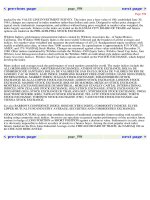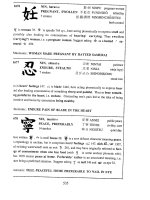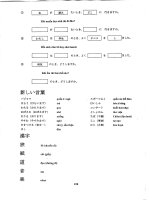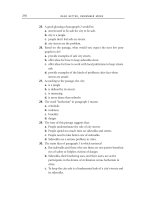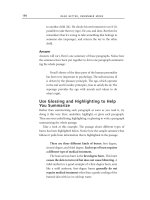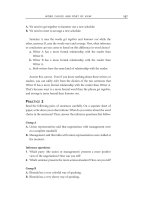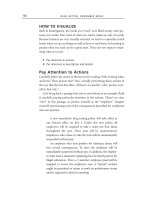READ BETTER REMEMBER MORE 2e phần 9 pps
Bạn đang xem bản rút gọn của tài liệu. Xem và tải ngay bản đầy đủ của tài liệu tại đây (122.67 KB, 22 trang )
READ BETTER, REMEMBER MORE
194
to another child (id). He checks his environment to see if it’s
possible to take that toy (ego). He can, and does. But then he
remembers that it’s wrong to take something that belongs to
someone else (superego), and returns the toy to the other
child.
Answer
Answers will vary. Here’s one summary of these paragraphs. Notice how
the sentences have been put together to form one paragraph summariz-
ing the whole passage:
Freud’s theory of the three parts of the human personality
has been very important in psychology. The subconscious id
is driven by the pleasure principle. The ego, which operates
in the real world (reality principle), tries to satisfy the id. The
superego provides the ego with morals and values to do
what’s right.
Use Glossing and Highlighting to Help
You Summarize
Rather than summarizing each paragraph as soon as you read it, try
doing it this way: First, underline, highlight, or gloss each paragraph.
Then use your underlining, highlighting, or glossing to write a paragraph
summarizing the whole passage.
Take a look at this example. The passage about different types of
burns has been highlighted below. Notice how the sample summary that
follows it pulls from information that is highlighted in the passage.
There are three different kinds of burns: first degree,
second degree, and third degree. Each type of burn requires
a different type of medical treatment.
The least serious burn is the first degree burn. This burn
causes the skin to turn red but does not cause blistering.A
mild sunburn is a good example of a first-degree burn, and,
like a mild sunburn, first-degree burns generally do not
require medical treatment other than a gentle cooling of the
burned skin with ice or cold tap water.
PUTTING IT IN YOUR OWN WORDS
195
Second degree burns, on the other hand, do cause blis-
tering of the skin and should be treated immediately. These
burns should be immersed in warm water and then
wrapped in a sterile dressing or bandage. (Do not apply
butter or grease to these burns; despite the old wives’ tale,
butter does not help burns heal and actually increases the
chances of infection.) If second degree burns cover a large
part of the body, then the victim should be taken to the hos-
pital immediately for medical care.
Third degree burns are those that char the skin and turn
it black or burn so deeply that the skin shows white. These
burns usually result from direct contact with flames and have
a great chance of becoming infected. All third degree burn
victims should receive immediate hospital care.Burns
should not be immersed in water, and charred clothing
should not be removed from the victim as it may also remove
skin. If possible a sterile dressing or bandage should be
applied to burns before the victim is transported to the hos-
pital.
Sample Summary:
Each of the three types of burns should be treated differently.
Because first degree burns do not blister, they do not need
medical attention. A burn that blisters is a second degree
burn and must be soaked in warm water, then dressed with a
sterile bandage. If the skin is charred (third degree burn), the
victim should go to the hospital immediately.
PRACTICE 2
The passage below may be a little more difficult, since the ideas are not
presented in neat paragraphs with clear topic sentences. Re-read this
news article about the toxic chemical leak and decide what the main ideas
and key pieces of information are. Highlight, underline, or gloss the
passage. Then, summarize the article in a paragraph on a separate sheet
of paper. Remember, minor supporting facts and specific details don’t
belong in a summary. Stick to the main ideas and most important facts.
READ BETTER, REMEMBER MORE
196
ABC Chemical of Williamsburg, Ohio, is in hot water.
Local environmentalists discovered last week that the com-
pany’s plant has been leaking toxic chemicals into the town’s
water supply.
Records indicate that there has been a large increase in
stomach ailments and short-term memory loss in the area.
The company spokesperson, Mel Gerardi, insists that
ABC Chemical executives knew nothing of the leak.
According to Gerardi, the company passed the city’s
Environmental Commission inspection just last month.
How the leak went undetected, he says, is a mystery.
Local residents have threatened ABC Chemical with a
class-action suit for negligence.
A similar case is pending in Richdale, Arkansas, where a
pesticide company was found to have been emitting toxic
fumes into the neighborhood. For several weeks, residents
had complained of stomach pain and general nausea as well
as difficulty remembering things. The cause was eventually
traced back to the pesticide plant.
Answer
Answers will vary. Here’s one sample summary:
Residents in an Ohio town have been sickened by toxic
chemicals leaked by a local chemical company into the
town’s water supply. The leak was not detected in a recent
inspection. Residents are suing the company for negligence.
A pesticide company in Arkansas is also being sued for sick-
ening residents with toxic fumes.
PARAPHRASING
Although summarizing is the strategy to choose when you want to focus
on the main idea, when a passage is particularly difficult, you’ll often
benefit more from paraphrasing. To paraphrase means to take someone
else’s ideas and restate them in your own words. The main difference
between paraphrasing and summarizing is that a paraphrase isn’t limited
to the main idea. When you paraphrase a paragraph, you put each idea in
PUTTING IT IN YOUR OWN WORDS
197
that paragraph into your own words, whether it’s the main idea, a major
supporting idea, or minor support. Thus, you can be sure you under-
stand an idea before you try to remember it.
Whereas a summary is usually no more than one fourth the size of its
source, a paraphrase should be the same size as the original. That is, if
you’re paraphrasing a paragraph with five sentences, your paraphrase
should also contain about five sentences. That’s because you are not
cutting out minor supporting ideas and details.
The important thing to watch out for when paraphrasing is not to
change the writer’s ideas. Often when readers process information like
this, it’s easy to include their own feelings about the topic in their para-
phrase. But when you summarize or paraphrase, you need to stick to
what the writer is saying. Save your own ideas for your notes and
comments in the margin.
Paraphrase Ideas, Not Words
The key to a good paraphrase is to work idea by idea, not word by word.
The trouble with going word by word is that you’re likely to simply
substitute one word for another (synonyms) without really making the
ideas your own. Read a sentence, understand the whole idea it conveys,
and then put that idea into your own words just like you did for your
summaries. See the following example to get you started.
Original sentence:
Under managed care systems, more and more emphasis is
being placed on pre-care and post-care, which means placing
more and more responsibility for healthcare delivery in the
hands of allied health workers.
Poor paraphrase (synonym substitution):
In managed care programs, greater and greater stress is put
on care before and after illnesses. As a result, greater and
greater responsibility for these services is given to workers in
allied health.
READ BETTER, REMEMBER MORE
198
Good paraphrase:
Increasingly, allied health workers are doing more as HMOs
focus on preventative care and follow-up treatments.
Notice that the good paraphrase is much more “processed” than the
poor one. It has a different structure as well as different words.
You’ll keep away from synonym substitution if you don’t look right at
the text as you’re trying to paraphrase it. That is, once you understand the
idea, put the text aside. Then paraphrase. If you have it right in front of
you, you may be tempted to substitute synonyms.
P
RACTICE 3
Scientific texts are often difficult to follow. Try paraphrasing the follow-
ing sentences to make sure you clearly understand them:
1. Evolution changes the genetic make-up of populations gradually over
time, and greater complexity and adaptability do occur.
2. The human species is unique in its great ability to control factors that
limit population growth in other species, and our species has there-
fore been growing exponentially for hundreds of years.
Answers
Answers will vary. Here are sample paraphrases:
1. Species can become more adaptable and complex through evolution,
which is the slow change of a group’s genetic structure.
2. Unlike other species, humans have conquered many of the problems
that keep population growth rates low. As a result, the number of
human beings on this planet has been increasing at a phenomenal rate
for several centuries.
PUTTING IT IN YOUR OWN WORDS
199
IN SHORT
To summarize and paraphrase, you need to understand the ideas and
information in the text and put those ideas into your own words.
Summaries should include only the main ideas and most important
supporting ideas. A paraphrase, on the other hand, should include all of
the writer’s ideas. Use summaries to remember the most important
information in what you read. Paraphrase to help you understand diffi-
cult sentences or ideas.
Skill Building Until Next Time
1. Write a brief summary of this chapter on a separate sheet of paper.
2. If you come across any difficult sentences in your reading this
week, paraphrase them. Take each idea and put it into your own
words.
CHAPTER
20
P
UTTING
I
T
A
LL
T
OGETHER
This last chapter reviews
the strategies you learned
in Chapters 15–20:
analyzing word choice
and point of view,
determining tone, finding
the implied main idea,
summarizing, and
paraphrasing. You’ll put
all of this knowledge to
practice in a review that
brings in all the
strategies you’ve learned
throughout this book.
C
ongratulations! You’re in the home stretch.
You’ve been building your reading skills chapter by chapter
throughout this book, and now it’s time to pull your skills all
together in a final review. Here is one long passage in which you’ll prac-
tice strategies from this section as well as sections 1–3. But first, here’s a
review of what you’ve learned in this section.
IN BRIEF
• Chapter 16: Word Choice and Point of View. Writers choose their
words carefully to reflect their attitude towards their subject. You
READ BETTER, REMEMBER MORE
202
learned how to look for clues in word choice and point of view to
make inferences about the writer’s attitude.
• Chapter 17: Determining Tone. You learned how word choice and
point of view work together to create tone. Tone is the mood or
attitude conveyed by words or speech. You practiced recognizing a
variety of different tones of voice and made observations to
support your inferences and boost your retention.
• Chapter 18: Finding an Implied Main Idea. You learned how to
work like a detective and find clues to determine the main idea
when the writer doesn’t provide clear topic sentences. You looked
at word choice, point of view, and tone to see what main idea all of
the other sentences in the passage added up to.
• Chapter 19: Putting It in Your Own Words. You practiced two
powerful reading strategies: summarizing and paraphrasing. You
learned how to “process” what you read and “translate” those ideas
into your own words. When you summarized, you focused on the
main idea and key support and put them into your own words.
When you paraphrased, you rewrote sentences idea by idea.
If any of these terms or strategies sound unfamiliar to you, STOP. Take
a few minutes to review the chapter or concept that is unclear.
PRACTICE
Here’s one long passage about taxes. Pre-read first, and then answer the
pre-reading question. Then, read the passage carefully. Keep in mind the
following points, which are essential parts of this exercise:
• You may use your vocabulary list, but not a dictionary.
• As you read, write your questions and reactions in the margin.
• Highlight or underline the text as you read.
Pre-Reading Question:
1. Based on your pre-reading, what do you expect to learn from this
passage? On a separate sheet of paper, write several questions that you
expect the passage to answer.
PUTTING IT ALL TOGETHER
203
Change the Tax System
Every year, April 15th comes around like a recurring night-
mare. Citizens brace themselves for the agony of complicated
forms and hours of gathering numbers and receipts to figure
out how much more of their hard-earned money they’ll be
forced to give to Uncle Sam. It’s a task and a system that cit-
izens loathe, and it’s time for a serious restructuring of the
U.S. tax system.
Citizens are currently being taxed for working hard and
saving money—two activities we should encourage. Instead,
citizens should be taxed for the “bad” things that they do.
That is, they should be taxed on the things that deplete our
natural resources, pollute our environment, and create
waste. These taxes fall into three categories: taxes on energy
consumption, taxes on health deterrents, and taxes on luxu-
ry. At the same time that these taxes are increased, taxes on
earnings and savings should be reduced proportionately.
Taxes on Energy Consumption
The gasoline that we put in our cars pollutes the air and
drains our natural resources. Traffic jams clog our streets and
create noise pollution. A higher tax on gasoline, on oil, and
on cars and car parts would encourage people to conserve
gas, to carpool, to use public transportation, and to walk or
ride bicycles when possible. Citizens would then benefit from
cleaner air and healthier bodies.
Electricity and other forms of energy should also be taxed
at higher rates to help us conserve our natural resources.
Increased taxes on electricity would encourage people to
turn off lights and appliances when not in use. In addition, it
would discourage people from buying gadgets they don’t
need, like salad shooters and electronic calendars. Citizens
would hang their clothes to dry more often instead of run-
ning the dryer, would use a regular toothbrush instead of an
electric one, and would cook their food in ovens rather than
the microwave (a much healthier choice).
READ BETTER, REMEMBER MORE
204
Taxes on Health Deterrents
Cigarettes and alcohol are already taxed—but they should
be taxed more. The tremendous burden in health care costs
created by these habits alone should warrant higher taxes on
these addictive substances. Higher taxes on cigarettes and
alcohol will help reduce the number of people addicted to
these substances. Children and teens will be less able to
afford these items, and adults will consider whether their
habit is really worth the hole it’s burning in their pocket.
We’ll have a healthier population and reduce overall health
care costs.
Taxes on Luxury
Despite America’s large middle class, a great majority of
wealth in this country is still in the hands of a very few.
Those citizens who are wealthy enough to afford such luxu-
ry purchases as jet airplanes, yachts, summer and winter
homes, car collections, fur coats, jewels, and other unneces-
sary items should pay higher taxes on these purchases. That
way, citizens who have to struggle just to put food on the
table can be taxed less.
Benefits for Everybody
Even if the average citizen ends up paying the same amount
in taxes, the system should still be changed to tax the bad, not
the good. Taxpayers would certainly feel much better about
giving money to Uncle Sam, and who knows? We might get
a few people to break a few bad habits in the process.
2. What does recurring (paragraph 1) mean?
a. happening over and over
b. current
c. very bad, frightening
3. What does warrant (paragraph 5) mean?
a. explain
b. arrest
c. justify
PUTTING IT ALL TOGETHER
205
4. What is the overall main idea of this passage? State it in your own
words.
5. How is this passage organized?
a. cause and effect
b. most important to least important
c. analysis/classification
6. Identify two opinions.
7. What is the tone of paragraph 1?
a. apologetic
b. indignant
c. demanding
8. Summarize this passage in one paragraph.
Answers
1. From the headings in the passage, you might expect to get answers to
the following questions:
• Why change the tax system?
• How should the tax system be changed?
• What kind of taxes are there on energy consumption? (What falls
into this category of “energy consumption”?)
• What kind of taxes are there on health deterrents? (What are these
“health deterrents”?)
• What kind of taxes should there be on health deterrents?
• What kind of taxes are there on luxury? (What is considered
“luxury”?)
• What kind of taxes should there be on luxury?
• What benefits will there be for everybody?
2. a. Recurring means happening over and over. Tax time comes around
every year, without fail.
3. c. Warrant means justify. The paragraph says that smoking and
drinking create a large burden on health care costs, and the writer
suggests that this is reason enough to raise taxes on these items.
4. The overall main idea of this passage, stated in the second paragraph,
might be restated as follows: The tax system should be restructured so
people are taxed for wasting, not for working.
5. The passage is organized by analysis/classification, c. The writer
READ BETTER, REMEMBER MORE
206
explains the different groups of taxes. The sentence “These taxes fall
into three categories” should help you anticipate this organizational
pattern.
6. Opinions include the following sentences: “It’s a task and a system that
citizens loathe, and it’s time for a serious restructuring of the U.S. tax
system”; “two activities we should encourage”; and “citizens should be
taxed for the ‘bad’ things that they do.” In fact, most of this passage is
opinion. You should not have underlined sentences like “The gasoline
that we put in our cars pollutes the air and drains our natural
resources.”
7. The tone of paragraph 1 is b, indignant. Words like “recurring night-
mare,”“brace themselves,”“agony,” and especially “how much more of
their hard-earned money they’ll be forced to give to Uncle Sam”clearly
suggest that the writer feels indignant (angry about something
thought to be unjust or unfair).
8. Answers will vary. Here’s one summary of the passage:
The U.S. tax system, which currently punishes citizens by
taxing them for money they earn and save, should tax citi-
zens for what they consume instead. Taxes on gas, electricity
and other forms of energy should be raised to encourage cit-
izens to conserve these resources. Taxes on cigarettes and
alcohol should also be raised to discourage smoking and
drinking and reduce health care costs. Taxes on luxury items
should also be raised to reduce wasteful spending.
Meanwhile, taxes on earnings and savings should be reduced,
so citizens can feel better about how they’re being taxed.
In addition, here’s an example of how you might have underlined and
reacted to the first part of the passage:
Change the Tax System
Every year, April 15
th
comes around like a recurring nightmare.
Citizens brace themselves for the agony of complicated forms
and hours of gathering numbers and receipts to figure out how
much more of their hard-earned money they’ll be forced to
I dread 4/15!
yes, but
the short
form is
pretty
easy
PUTTING IT ALL TOGETHER
207
give to Uncle Sam. I
t’s a task and a system that citizens loathe,
and it
’s time for a serious restructuring of the U.S. tax system.
Citizens are currently being taxed for working hard and
sav
ing money—two activities we should encourage. I
nstea
d,
citiz
ens should be taxed for the “
bad” things that they do.
That is, they should be taxed on the things that deplete our
natural resources, pollute our environment, and create
waste. These taxes fall into three categories: taxes on energy
consumption, taxes on health deterrents, and taxes on luxury.
A
t the same time that these taxes are increased, taxes on
ear
nings and saving
s should be reduced proportionately.
Taxes on Energy Consumption
The gasoline that we put in our cars pollutes the air and
drains our natural resources. Traffic jams clog our streets and
create noise pollution. A higher tax on gasoline, on oil, and
on cars and car parts w
ould encour
age pe
ople to conserve
gas, to carpool, to use public transportation, and to walk or
ride bicycles when possible. Citizens would then benefit from
cleaner air and healthier bodies.
If you missed Then review
Question 1 Chapter 1
Question 2 Chapter 4
Question 3 Chapter 4
Question 4 Chapter 6
Question 5 Chapter 11
Question 6 Chapter 12
Question 7 Chapter 17
Question 8 Chapter 19
I hadn’t thought of
it like this before
That would be nice
I agree
True, but then I couldn’t
drive to work by myself
every day
READ BETTER, REMEMBER MORE
208
Congratulations!
You’ve completed 20 chapters and are now better able to understand and
remember what you read. Good work. Go ahead and take the post-test to
see how much your reading skills have improved
Suggestions for how to continue improving your reading skills, along
with a list of suggested books organized by subject appears in Appendix A.
Appendix B offers four charts: common prefixes, suffixes, Latin word
roots, and Greek word roots. Studying these charts will help you to
increase your vocabulary, which in turn will help you to understand
more of what you read.
Now it’s time to reward yourself for a job well done. Buy yourself a
good book and enjoy!
I
f you’d like to gauge how much your reading
comprehension and retention skills have improved since you
started this book, try this post-test. Though the questions are differ-
ent from the pretest, the format is the same, so you will be able to
directly compare results. The only key difference between these two tests
is that the post-test uses more of the vocabulary words you’ve learned
throughout this book.
When you complete this test, grade yourself, and then compare your
pre- and post-test scores. If you scored much higher on the post-test,
congratulations; you’ve profited noticeably from your hard work. If your
score shows little improvement, perhaps there are certain chapters you
need to review. Do you notice a pattern to the types of questions you got
wrong?
P
OST-TEST
READ BETTER, REMEMBER MORE
210
Whatever your score on this post-test, keep this book around for
review. Refer to it whenever you need tips on how to better understand
and remember what you read.
Circle the correct answers below, or if this book doesn’t belong to you,
write the numbers 1–30 on a piece of paper and record your answers
there.
Take as much time as you need to complete this post-test (plan on
about a half an hour). When you finish, check your answers against the
answer key that follows this test. Each answer tells you which chapters
correspond to the strategies in that question.
Good luck!
Note: Do not use a dictionary for this post-test.
PART I
1. Before you read, you should:
a. Set a time limit for your reading.
b. Break up your reading into manageable tasks.
c. Read the introduction and skim the section headings.
d. (a) and (c)
e. (b) and (c)
2. A dictionary definition typically includes:
a. the main meaning of the word and variations of that word
b. the part of speech and various meanings of the word
c. the meaning of the word and related words
d. the context in which the word is used
3. The main idea of a text is:
a. an assertion that requires support
b. support for the topic sentence
c. a transition
d. all of the above
4. The subject of a text is the same as the main idea.
a. true
b. false
c. sometimes true
POST-TEST
211
5. To gloss a text, you should:
a. highlight key terms
b. rewrite the major supporting ideas in each paragraph
c. briefly summarize the main idea of each paragraph
d. paraphrase each paragraph
6. To highlight a text, you should:
a. highlight key terms
b. highlight unfamiliar words
c. highlight main ideas and major supporting ideas
d. (a) and (c)
e. ( a) and (b)
7. A topic sentence is often:
a. the point of view
b. a supporting idea
c. the first or last sentence in a paragraph
d. a transitional sentence
8. Which of the following generally determines the tone of a passage?
a. the topic sentence
b. the author’s opinions
c. the word choice and point of view
d. the organizational strategy
9. A paraphrase should be:
a. about the same length as the text being paraphrased
b. about
1
⁄4 the size of the text being paraphrased
c. about twice as long as the text being paraphrased
d. the text copied word for word
10. The first person point of view:
a. creates distance and appears objective
b. puts the reader in the writer’s shoes
c. addresses the reader directly
d. is personal and subjective
PART II
Read the passages below carefully and answer the questions that follow.
READ BETTER, REMEMBER MORE
212
Passage 1
The sentences are numbered to make the questions easier to follow.
(1) There are many things you can do to make tax time easier. (2) The
single most important strategy is to keep accurate records. (3) Keep all
of your pay stubs, receipts, bank statements, and other relevant finan-
cial information in a neat, organized folder so that when you’re ready
to prepare your form, all of your paperwork is in one place. (4) The
second thing you can do is start early. (5) Get your tax forms from the
post office as soon as they are available and start calculating. (6) This
way, if you run into any problems, you have plenty of time to
straighten them out. (7) You can also save time by reading the direc-
tions carefully. (8) This will prevent time-consuming errors. (9)
Finally, if your taxes are relatively simple (you don’t have itemized
deductions or special investments), use the shorter tax form. (10) It’s
only one page, and if your records are in order, it can be completed in
less than an hour.
11. The main idea of this passage is expressed in which sentence?
a. 1
b. 3
c. 7
d. 10
12. This paragraph uses which of the following organizational
strategies?
a. cause and effect
b. analysis/classification
c. order of importance
d. chronology
13. This passage uses which point of view?
a. first person
b. second person
c. third person
d. first and second person
POST-TEST
213
14. How many suggestions for tax time does this passage offer?
a. one
b. two
c. three
d. four
15. The sentence “It’s only one page, and if your records are in order, it
can be completed in less than an hour” is:
a. the main idea of the passage
b. a major supporting idea
c. a minor supporting idea
d. a transitional sentence
16. A good summary of this passage would be:
a. Simple strategies can make tax time less taxing.
b. Don’t procrastinate at tax time.
c. Always keep good records.
d. Get a tax attorney.
17. According to the passage, who should use the shorter tax form?
a. Everybody.
b. People who do not have complicated finances.
c. People who do have complicated finances.
d. People who wait until the last minute to file taxes.
18. The sentence “The single most important strategy is to keep accurate
records” is a:
a. fact
b. opinion
c. both
d. neither
19. Which is the most effective underlining of the following passage?
a. You can also save time by reading the directions carefully. This
will prevent time-consuming e
rrors. Finally, if your taxes are
r
e
latively simple (you don’t have itemized deductions or special
investments), use the shorter tax form. It’s only one page, and if
y
our r
ecords are in order, it can be completed in less than an
hour.
b. You can also save time by reading the directions carefully. This
will prevent time-consuming errors. Finally, if your taxes are
relatively simple (you don’t have itemized deductions or special
READ BETTER, REMEMBER MORE
214
in
vestments), use the shorter tax form. It’s only one page, and if
your records are in order, it can be completed in less than an
hour.
c. You can also save time by r
eading the dire
ctions carefully
. This will
prevent time-consuming errors. Finally, if your taxes are relatively
simple (you don’t have itemized deductions or special invest-
ments), use the sho
rter tax form
. It’s only one page, and if your
records are in order, it can be completed in less than an hour.
d. You can also sa
ve time by reading the directions carefully. This will
prevent time-consuming errors. Finally, if your taxes are relatively
simple
(you don’t have itemized deductions or special invest-
ments), use the shorter tax form. It’s only one page, and if your
records are in order, it can be completed in less than an hour
.
PASSAGE 2
The following passage is excerpted from Jane Jacobs’s 1961 book, The
Death and Life of Great American Cities. The paragraphs are numbered to
make the questions easier to follow.
(1) A city sidewalk by itself is nothing. It is an abstraction. It means
something only in conjunction with the buildings and other uses that
border it, or border other sidewalks very near it. The same might be
said of streets, in the sense that they serve other purposes besides
carrying wheeled traffic in their middles. Streets and their sidewalks,
the main public places of a city, are its most vital organs. Think of a
city and what comes to mind? Its streets. If a city’s streets look inter-
esting, the city looks interesting; if they look dull, the city looks dull.
(2)More than that, and here we get down to the first problem, if a
city’s streets are safe from barbarism and fear, the city is thereby toler-
ably safe from barbarism and fear. When people say that a city, or a
part of it, is dangerous or is a jungle, what they mean primarily is that
they do not feel safe on the sidewalks.
(3) But sidewalks and those who use them are not passive benefi-
ciaries of safety or helpless victims of danger. Sidewalks, their border-
ing uses, and their users, are active participants in the drama of
civilization versus barbarism in cities. To keep the city safe is a funda-
mental task of a city’s streets and its sidewalks.
POST-TEST
215
(4) This task is totally unlike any service that sidewalks and streets
in little towns or true suburbs are called upon to do. Great cities are
not like towns, only larger. They are not like suburbs, only denser.
They differ from towns and suburbs in basic ways, and one of these is
that cities are, by definition, full of strangers
(5) The bedrock attribute of a successful city district is that a person
must feel personally safe and secure on the street among all these
strangers. He must not feel automatically menaced by them. A city
district that fails in this respect also does badly in other ways and lays
up for itself, and for its city at large, mountain on mountain of trouble.
20. According to the passage, cities are different from towns because:
a. they are much bigger
b. they have crowded streets
c. most people are unfriendly
d. most people are strangers
21. According to the passage, a city district is successful if:
a. its streets are clean
b. people feel safe on the streets
c. people feel safe in their houses
d it feels like the suburbs
22. The word “menaced” (paragraph 5) means:
a. threatened
b. disliked
c. rejected
d. nervous
23. According to the passage, the state of a city sidewalk shows:
a. the neglect of the people who live on that block
b. the politicians who govern that district of the city
c. the health of that part of the city
d. the battle between safety and danger
e. (a) and (d)
24. A good paraphrase of the last sentence in paragraph 1 is:
a. Cities can look both interesting and dull.
b. Look carefully at city streets and sidewalks.
c. A city is reflected in its streets.
d. Avoid dull city streets.

